SQL加强
SQL强化
SQL执行顺序
--举例:
select
a.sex,
b.city,
count(1) as cnt,
sum(salary) as sum1
from table1 a
join table2 b on a.id=b.id
where a.name=b.name
group by a.sex,b.city
having cnt>=2
order by a.sex,b.city
limit 10
--或者是
select distinct
a.sex,
b.city,
a.age
from table1 a
join table2 b on a.id=b.id
where a.name=b.name
order by a.sex,b.city
limit 10上面的SQL语句的执行顺序是: from (去加载table1 和 table2这2个表 ) -> join -> on -> where -> group by->select 后面的聚合函数count,sum -> having -> distinct -> order by -> limit
--on 和where的先后顺序讨论
--下面用left join 各得到结果,结果不一样。
--下面可知,先执行on,再执行where
select *
from table1 a
left join table2 b
on a.id=b.id
where a.name=b.name;
--下面的条数可能会比上面多。
select *
from table1 a
left join table2 b
on a.id=b.id
and a.name=b.name;
--下面用inner join 各得到结果,结果是一样的
select *
from table1 a
join table2 b
on a.id=b.id
where a.name=b.name;
select *
from table1 a
join table2 b
on a.id=b.id
and a.name=b.name;hivesql与sparkSQL的区别:
- 子查询hive必须起别名,SparkSQL可以不用起别名
- group by xx,yy,hive不用能用别名,spark可以用别名
- hive不支持临时视图和缓存表,SparkSQL都支持
--用SparkSQL的临时视图
use interview_db;
create or replace temporary view t_view1 as
select *,
if(month=1,amount,0) as a1,
if(month=2,amount,0) as a2,
if(month=3,amount,0) as a3,
if(month=4,amount,0) as a4
from table2;select year, sum(a1) as m1, sum(a2) as m2, sum(a3) as m3, sum(a4) as m4 from t_view1 group by year;
--使用SparkSQL的缓存表
cache table cached1 as
select *,
if(month=1,amount,0) as a1,
if(month=2,amount,0) as a2,
if(month=3,amount,0) as a3,
if(month=4,amount,0) as a4
from table2;
select * from cached1;
select year,
sum(a1) as m1,
sum(a2) as m2,
sum(a3) as m3,
sum(a4) as m4
from cached1
group by year;
- 爆炸函数,hive不支持explode与普通字段联合使用,需要用侧视图分开,SparkSQL支持联合使用
sql
use interview_db;
select qq,game1 from tableB lateral view explode(split(game,'_')) view1 as game1 ;
--spark还支持这样,但是hive不支持:
select qq,explode(split(game,'_')) game1 from tableB ;
- sparkSQL支持300多种函数,hiveSQL支持200多种函数。sparkSQL函数比hiveSQL要多。
- 比如SparkSQL有sequence,count_if函数,hive就没有
hive10题
- 先配置环境
- 在pycharm或datagrip或idea中配置hive数据源。也可以配置一个sparkSQL数据源,来加快速度。
- 如果配置hive数据源:
- 需要提前启动hdfs和yarn,hive的metastore,hive的hiveserver2
#启动hdfs和yarn
start-all.sh
# hive的metastore
nohup /export/server/hive/bin/hive --service metastore 2>&1 > /tmp/hive-metastore.log &
#hive的hiveserver2
#hiveserver2开启后,等过2分钟后才能生效。
nohup /export/server/hive/bin/hive --service hiveserver2 2>&1 > /tmp/hive-hiveserver2.log &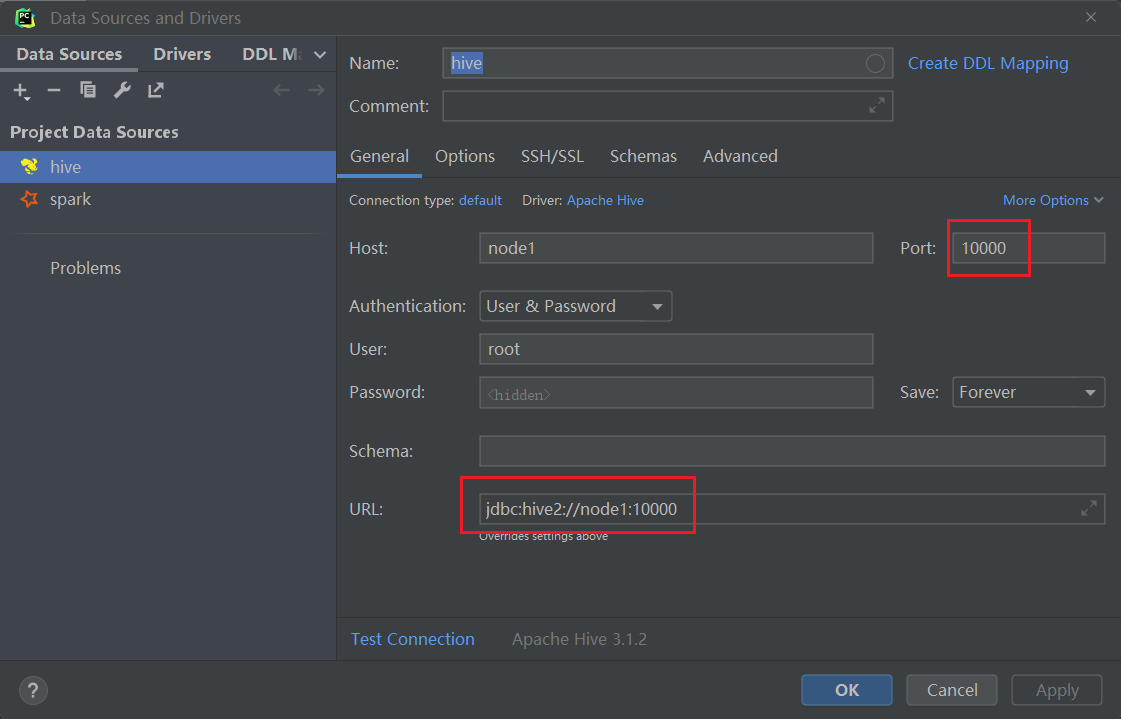
- 如果遇到下面的问题

- 解决办法
hive/conf/hive-env.sh中加入
export HADOOP_CLIENT_OPTS=" -Xmx512m"
export HADOOP_HEAPSIZE=1024
改完重启hiveserver2- 如果配置SparkSQL数据源
- 需要提前启动hdfs,hive的metastore,Spark的Thriftserver服务。
#启动hdfs和yarn
start-all.sh
# hive的metastore
nohup /export/server/hive/bin/hive --service metastore 2>&1 > /tmp/hive-metastore.log &
#Spark的Thriftserver服务
/export/server/spark/sbin/start-thriftserver.sh \
--hiveconf hive.server2.thrift.port=10001 \
--hiveconf hive.server2.thrift.bind.host=node1 \
--master local[*]- 下面是spark3集成hive3需要的jar包,如果是spark2集成hive2,则jar包不一样。
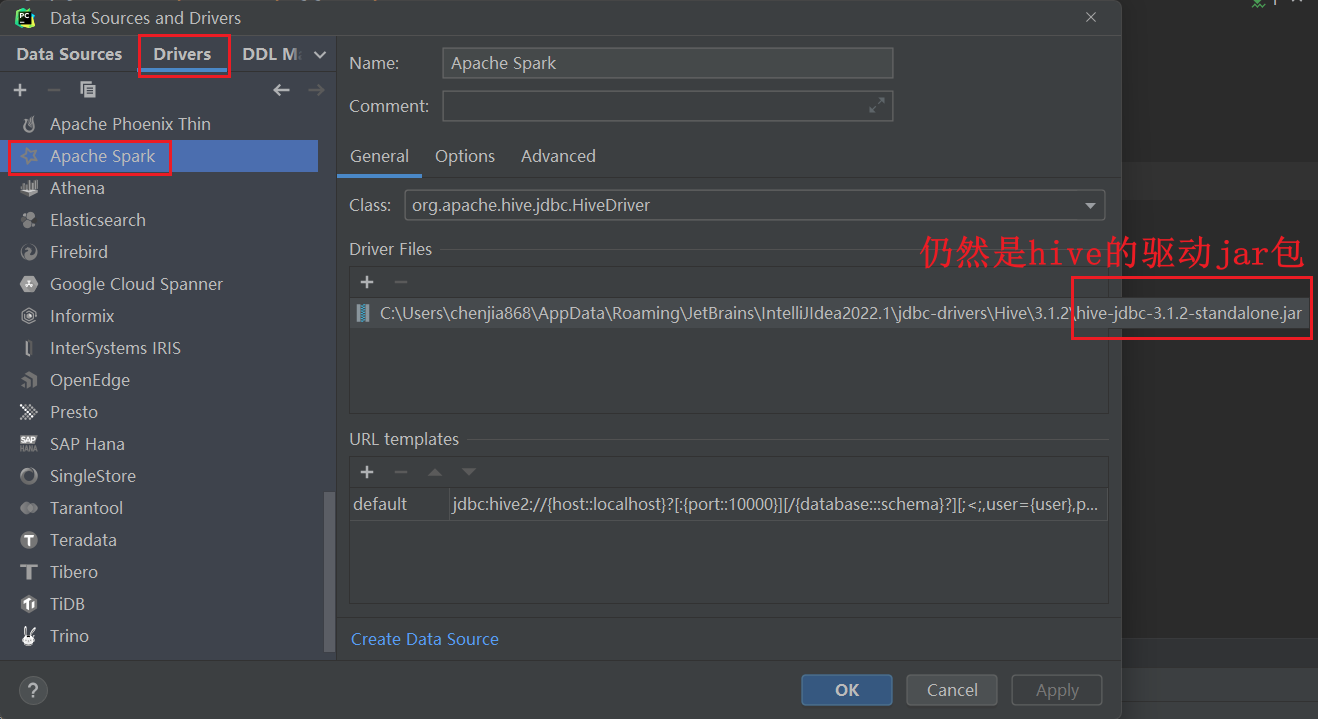
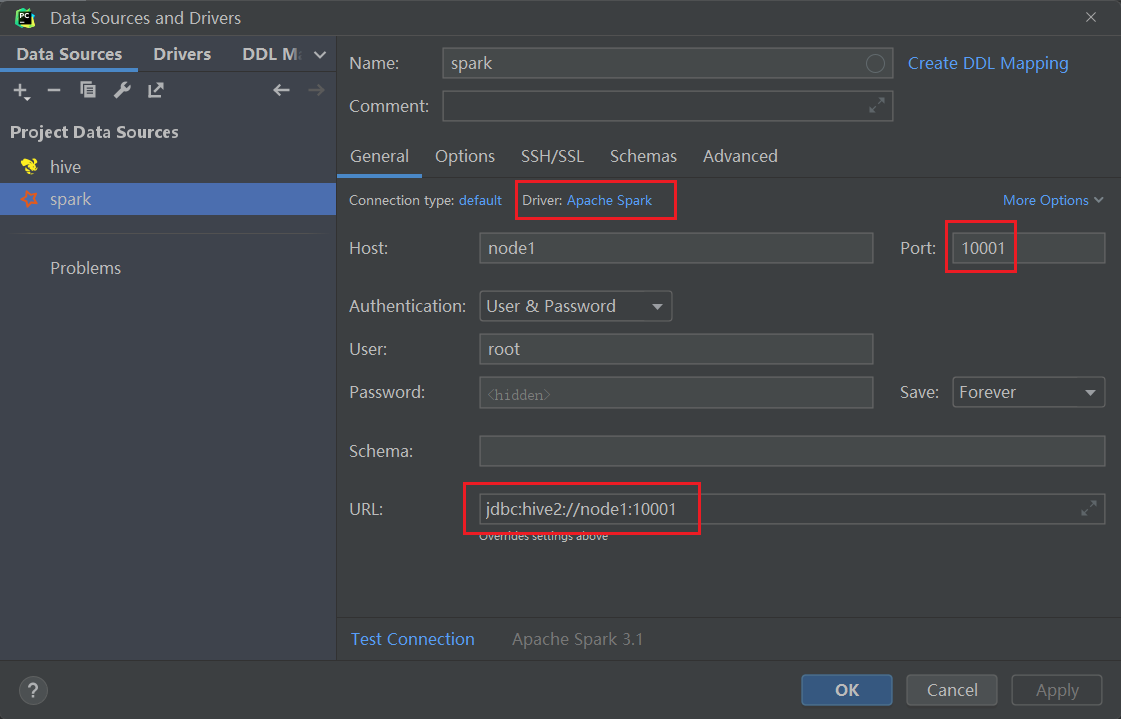
show databases ;
create database if not exists test_sql;
use test_sql;
-- 一些语句会走 MapReduce,所以慢。 可以开启本地化执行的优化。
set hive.exec.mode.local.auto=true;-- (默认为false)
--第1题:访问量统计
CREATE TABLE test_sql.test1 (
userId string,
visitDate string,
visitCount INT )
ROW format delimited FIELDS TERMINATED BY "\t";
INSERT overwrite TABLE test_sql.test1
VALUES
( 'u01', '2017/1/21', 5 ),
( 'u02', '2017/1/23', 6 ),
( 'u03', '2017/1/22', 8 ),
( 'u04', '2017/1/20', 3 ),
( 'u01', '2017/1/23', 6 ),
( 'u01', '2017/2/21', 8 ),
( 'u02', '2017/1/23', 6 ),
( 'u01', '2017/2/22', 4 );
select *,
sum(sum1) over(partition by userid order by month1 /*rows between unbounded preceding and current row*/ ) as `累积`
from
(select userid,
date_format(replace(visitdate,'/','-'),'yyyy-MM') as month1,
sum(visitcount) sum1
from test_sql.test1
group by userid,
date_format(replace(visitdate,'/','-'),'yyyy-MM')) as t;
-- 第2题:电商场景TopK统计
CREATE TABLE test_sql.test2 (
user_id string,
shop string )
ROW format delimited FIELDS TERMINATED BY '\t';
INSERT INTO TABLE test_sql.test2 VALUES
( 'u1', 'a' ),
( 'u2', 'b' ),
( 'u1', 'b' ),
( 'u1', 'a' ),
( 'u3', 'c' ),
( 'u4', 'b' ),
( 'u1', 'a' ),
( 'u2', 'c' ),
( 'u5', 'b' ),
( 'u4', 'b' ),
( 'u6', 'c' ),
( 'u2', 'c' ),
( 'u1', 'b' ),
( 'u2', 'a' ),
( 'u2', 'a' ),
( 'u3', 'a' ),
( 'u5', 'a' ),
( 'u5', 'a' ),
( 'u5', 'a' );
--(1)每个店铺的UV(访客数)
-- UV和PV
-- PV是访问当前网站所有的次数
-- UV是访问当前网站的客户数(需要去重)
--(2)每个店铺访问次数top3的访客信息。输出店铺名称、访客id、访问次数
select shop,
count(distinct user_id) as uv
from test_sql.test2 group by shop ;
--上面的拆解来看,等价于
--distinct后可以接多个字段,表示联合去重
select shop,
count(user_id) as uv
from
(select distinct shop,
user_id
from test_sql.test2 ) as t
group by shop ;
--也等价于
select shop,
count(user_id) as uv
from
(select shop,
user_id
from test_sql.test2 group by shop, user_id) as t
group by shop ;
select * from
(select *,
row_number() over (partition by shop order by cnt desc) as rn
from
(select shop,user_id,count(1) as cnt from test_sql.test2 group by shop,user_id ) as t) t2
where t2.rn<=3;
-- 第3题:订单量统计
CREATE TABLE test_sql.test3 (
dt string,
order_id string,
user_id string,
amount DECIMAL ( 10, 2 ) )
ROW format delimited FIELDS TERMINATED BY '\t';
INSERT overwrite TABLE test_sql.test3 VALUES
('2017-01-01','10029028','1000003251',33.57),
('2017-01-01','10029029','1000003251',33.57),
('2017-01-01','100290288','1000003252',33.57),
('2017-02-02','10029088','1000003251',33.57),
('2017-02-02','100290281','1000003251',33.57),
('2017-02-02','100290282','1000003253',33.57),
('2017-11-02','10290282','100003253',234),
('2018-11-02','10290284','100003243',234);
-- (1)给出 2017年每个月的订单数、用户数、总成交金额。
-- (2)给出2017年11月的新客数(指在11月才有第一笔订单)
select date_format(dt,'yyyy-MM') as month1,
count(distinct order_id) as cnt1,
count(distinct user_id) as cnt2,
sum(amount) as amt
from test_sql.test3
where year(dt)=2017
group by date_format(dt,'yyyy-MM');
select count(user_id) cnt from
(select user_id,
min(date_format(dt,'yyyy-MM')) min_month
from test3 group by user_id) as t where min_month='2017-11';
--统计每个月的新客户数
select min_month,
count(user_id) cnt
from (select user_id,
min(date_format(dt, 'yyyy-MM')) min_month
from test3
group by user_id) as t
group by min_month;
-- 第4题:大数据排序统计
CREATE TABLE test_sql.test4user
(user_id string,name string,age int);
CREATE TABLE test_sql.test4log
(user_id string,url string);
INSERT INTO TABLE test_sql.test4user VALUES('001','u1',10),
('002','u2',15),
('003','u3',15),
('004','u4',20),
('005','u5',25),
('006','u6',35),
('007','u7',40),
('008','u8',45),
('009','u9',50),
('0010','u10',65);
INSERT INTO TABLE test_sql.test4log VALUES('001','url1'),
('002','url1'),
('003','url2'),
('004','url3'),
('005','url3'),
('006','url1'),
('007','url5'),
('008','url7'),
('009','url5'),
('0010','url1');
select * from test_sql.test4user ;
select * from test_sql.test4log ;
--有一个5000万的用户文件(user_id,name,age),
-- 一个2亿记录的用户看电影的记录文件(user_id,url),根据年龄段观看电影的次数进行排序?
--取整函数有 round,floor,ceil
select *,
round(x,0) as r,--四舍五入
floor(x) as f,--向下取整
ceil(x) as c--向上取整
from
(select 15/10 as x union all
select 18/10 as x union all
select 24/10 as x union all
select 27/10 as x ) as t;
select type,
sum(cnt) as sum1
from
(select *,
concat(floor(age/10)*10,'-',floor(age/10)*10+10) as type
from test_sql.test4user as a
-- join前最好提前减小数据量
join (select user_id,count(url) as cnt from test_sql.test4log group by user_id) as b
on a.user_id=b.user_id) as t
group by type
order by sum(cnt) desc;
-- 第5题:活跃用户统计
CREATE TABLE test5(
dt string,
user_id string,
age int)
ROW format delimited fields terminated BY ',';
INSERT overwrite TABLE test_sql.test5 VALUES ('2019-02-11','test_1',23),
('2019-02-11','test_2',19),
('2019-02-11','test_3',39),
('2019-02-11','test_1',23),
('2019-02-11','test_3',39),
('2019-02-11','test_1',23),
('2019-02-12','test_2',19),
('2019-02-13','test_1',23),
('2019-02-15','test_2',19),
('2019-02-16','test_2',19);
select * from test_sql.test5 order by dt,user_id;
--有日志如下,请写出代码求得所有用户和活跃用户的总数及平均年龄。(活跃用户指连续两天都有访问记录的用户)
-- type 总数 平均年龄
-- '所有用户' 3 27
-- '活跃用户' 1 19
with t1 as (select distinct dt, user_id,age from test_sql.test5),
t2 as (select *,row_number() over (partition by user_id order by dt) as rn from t1 ),
t3 as (select *,date_sub(dt,rn) as dt2 from t2),
t4 as (select dt2,user_id,age,count(1) cnt from t3 group by dt2,user_id,age),
t5 as (select * from t4 where cnt>=2),
t6 as (select distinct user_id,age from t5)
select '所有用户' as type, count(user_id) cnt,avg(age) as avg_age
from (select distinct user_id,age from test_sql.test5) t union all
select '活跃用户' as type, count(user_id) cnt,avg(age) as avg_age from t6;
-- 用思路2来分析连续2天登录
with t1 as (select distinct dt, user_id from test_sql.test5),
t2 as (select *,
date_add(dt,1) as dt2,
lead(dt,1)over(partition by user_id order by dt) as dt3
from t1)
select count(distinct user_id) from t2 where dt2=dt3;
-- 第6题:电商购买金额统计实战
CREATE TABLE test_sql.test6 (
userid string,
money decimal(10,2),
paymenttime string,
orderid string);
INSERT INTO TABLE test_sql.test6 VALUES('001',100,'2017-10-01','123'),
('001',200,'2017-10-02','124'),
('002',500,'2017-10-01','125'),
('001',100,'2017-11-01','126');
select * from test_sql.test6 order by userid,paymenttime;
--请用sql写出所有用户中在今年10月份第一次购买商品的金额,
select userid,paymenttime,money
from
(select *,
row_number() over (partition by userid order by paymenttime) as rn
from test_sql.test6 where date_format(paymenttime,'yyyy-MM')='2017-10' ) as t
where t.rn=1
;
-- 第7题:教育领域SQL实战
CREATE TABLE test_sql.book(book_id string,
`SORT` string,
book_name string,
writer string,
OUTPUT string,
price decimal(10,2));
INSERT INTO TABLE test_sql.book VALUES
('001','TP391','信息处理','author1','机械工业出版社','20'),
('002','TP392','数据库','author12','科学出版社','15'),
('003','TP393','计算机网络','author3','机械工业出版社','29'),
('004','TP399','微机原理','author4','科学出版社','39'),
('005','C931','管理信息系统','author5','机械工业出版社','40'),
('006','C932','运筹学','author6','科学出版社','55');
CREATE TABLE test_sql.reader (reader_id string,
company string,
name string,
sex string,
grade string,
addr string);
INSERT INTO TABLE test_sql.reader VALUES
('0001','阿里巴巴','jack','男','vp','addr1'),
('0002','百度','robin','男','vp','addr2'),
('0003','腾讯','tony','男','vp','addr3'),
('0004','京东','jasper','男','cfo','addr4'),
('0005','网易','zhangsan','女','ceo','addr5'),
('0006','搜狐','lisi','女','ceo','addr6');
CREATE TABLE test_sql.borrow_log(reader_id string,
book_id string,
borrow_date string);
INSERT INTO TABLE test_sql.borrow_log VALUES ('0001','002','2019-10-14'),
('0002','001','2019-10-13'),
('0003','005','2019-09-14'),
('0004','006','2019-08-15'),
('0005','003','2019-10-10'),
('0006','004','2019-17-13');
select * from test_sql.book;
select * from test_sql.reader;
select * from test_sql.borrow_log;
--(8)考虑到数据安全的需要,需定时将“借阅记录”中数据进行备份,请使用一条SQL语句,
-- 在备份用户bak下创建与“借阅记录”表结构完全一致的数据表BORROW_LOG_BAK.
-- 井且将“借阅记录”中现有数据全部复制到BORROW_L0G_ BAK中。
create table test_sql.BORROW_LOG_BAK as select * from test_sql.borrow_log;
select * from test_sql.BORROW_LOG_BAK;
--(9)现在需要将原Oracle数据库中数据迁移至Hive仓库,
-- 请写出“图书”在Hive中的建表语句(Hive实现,提示:列分隔符|;
-- 数据表数据需要外部导入:分区分别以month_part、day_part 命名)
CREATE TABLE test_sql.book2
(
book_id string,
`SORT` string,
book_name string,
writer string,
OUTPUT string,
price decimal(10, 2)
)partitioned by (month_part string,day_part string )
row format delimited fields terminated by '|';
--(10)Hive中有表A,现在需要将表A的月分区 201505 中
-- user_id为20000的user_dinner字段更新为bonc8920,其他用户user_dinner字段数据不变,
-- 请列出更新的方法步骤。(Hive实现,提示:Hive中无update语法,请通过其他办法进行数据更新)
--A
-- user_id user_dinner part
-- 20000 aaaaa 201505
-- 30000 bbbbb 201505
create table A (user_id int,user_dinner string) partitioned by (part string);
insert overwrite table A partition (part = '201505')
values (20000, 'aaaaa'),
(30000, 'bbbbb'),
(40000, 'ccccc');
select * from A;
--update A set user_dinner='bonc8920' where user_id=20000;
insert overwrite table A partition (part = '201505')
select user_id, 'bonc8920' as user_dinner from A where user_id=20000 and part = '201505' union all
select user_id, user_dinner from A where user_id!=20000 and part = '201505' ;
-- 第8题:服务日志SQL统计
CREATE TABLE test_sql.test8(`date` string,
interface string,
ip string);
INSERT INTO TABLE test_sql.test8 VALUES
('2016-11-09 11:22:05','/api/user/login','110.23.5.23'),
('2016-11-09 11:23:10','/api/user/detail','57.3.2.16'),
('2016-11-09 23:59:40','/api/user/login','200.6.5.166'),
('2016-11-09 11:14:23','/api/user/login','136.79.47.70'),
('2016-11-09 11:15:23','/api/user/detail','94.144.143.141'),
('2016-11-09 11:16:23','/api/user/login','197.161.8.206'),
('2016-11-09 12:14:23','/api/user/detail','240.227.107.145'),
('2016-11-09 13:14:23','/api/user/login','79.130.122.205'),
('2016-11-09 14:14:23','/api/user/detail','65.228.251.189'),
('2016-11-09 14:15:23','/api/user/detail','245.23.122.44'),
('2016-11-09 14:17:23','/api/user/detail','22.74.142.137'),
('2016-11-09 14:19:23','/api/user/detail','54.93.212.87'),
('2016-11-09 14:20:23','/api/user/detail','218.15.167.248'),
('2016-11-09 14:24:23','/api/user/detail','20.117.19.75'),
('2016-11-09 15:14:23','/api/user/login','183.162.66.97'),
('2016-11-09 16:14:23','/api/user/login','108.181.245.147'),
('2016-11-09 14:17:23','/api/user/login','22.74.142.137'),
('2016-11-09 14:19:23','/api/user/login','22.74.142.137');
select * from test_sql.test8;
--求11月9号下午14点(14-15点),访问/api/user/login接口的top10的ip地址
select ip, count(1) cnt
from test_sql.test8
where date_format(`date`, 'yyyy-MM-dd HH') = '2016-11-09 14'
and interface = '/api/user/login'
group by ip
order by cnt desc
limit 10
;
-- 第9题:充值日志SQL实战
CREATE TABLE test_sql.test9(
dist_id string COMMENT '区组id',
account string COMMENT '账号',
`money` decimal(10,2) COMMENT '充值金额',
create_time string COMMENT '订单时间');
INSERT INTO TABLE test_sql.test9 VALUES ('1','11',100006,'2019-01-02 13:00:01'),
('1','22',110000,'2019-01-02 13:00:02'),
('1','33',102000,'2019-01-02 13:00:03'),
('1','44',100300,'2019-01-02 13:00:04'),
('1','55',100040,'2019-01-02 13:00:05'),
('1','66',100005,'2019-01-02 13:00:06'),
('1','77',180000,'2019-01-03 13:00:07'),
('1','88',106000,'2019-01-02 13:00:08'),
('1','99',100400,'2019-01-02 13:00:09'),
('1','12',100030,'2019-01-02 13:00:10'),
('1','13',100003,'2019-01-02 13:00:20'),
('1','14',100020,'2019-01-02 13:00:30'),
('1','15',100500,'2019-01-02 13:00:40'),
('1','16',106000,'2019-01-02 13:00:50'),
('1','17',100800,'2019-01-02 13:00:59'),
('2','18',100800,'2019-01-02 13:00:11'),
('2','19',100030,'2019-01-02 13:00:12'),
('2','10',100000,'2019-01-02 13:00:13'),
('2','45',100010,'2019-01-02 13:00:14'),
('2','78',100070,'2019-01-02 13:00:15');
select * from test_sql.test9 order by dist_id , money desc;
--请写出SQL语句,查询充值日志表2019年01月02号每个区组下充值额最大的账号,要求结果:
--区组id,账号,金额,充值时间
select * from
(select *,
row_number() over (partition by dist_id order by money desc) rn
from test_sql.test9 where to_date(create_time)='2019-01-02') t
where t.rn=1;
-- 第10题:电商分组TopK实战
CREATE TABLE test_sql.test10(
`dist_id` string COMMENT '区组id',
`account` string COMMENT '账号',
`gold` int COMMENT '金币');
INSERT INTO TABLE test_sql.test10 VALUES ('1','77',18),
('1','88',106),
('1','99',10),
('1','12',13),
('1','13',14),
('1','14',25),
('1','15',36),
('1','16',12),
('1','17',158),
('2','18',12),
('2','19',44),
('2','10',66),
('2','45',80),
('2','78',98);
select * from test_sql.test10;
select * from
(select *,
row_number() over (partition by dist_id order by gold desc) rn
from test_sql.test10 ) t
where t.rn<=10;行转列(转置)
- 行转列的常规做法是,group by+sum(if())【或count(if())】
与行转列,对应相反的是,列转行,此时用explode+侧视图
华泰证券1
已知
| year | month | amount |
|---|---|---|
| 1991 | 1 | 1.1 |
| 1991 | 2 | 1.2 |
| 1991 | 3 | 1.3 |
| 1991 | 4 | 1.4 |
| 1992 | 1 | 2.1 |
| 1992 | 2 | 2.2 |
| 1992 | 3 | 2.3 |
| 1992 | 4 | 2.4 |
查成这样一个结果
| year | m1 | m2 | m3 | m4 |
|---|---|---|---|---|
| 1991 | 1.1 | 1.2 | 1.3 | 1.4 |
| 1992 | 2.1 | 2.2 | 2.3 | 2.4 |
解答
use test_sql;
set hive.exec.mode.local.auto=true;
create table table2(year int,month int ,amount double) ;
insert overwrite table table2 values
(1991,1,1.1),
(1991,2,1.2),
(1991,3,1.3),
(1991,4,1.4),
(1992,1,2.1),
(1992,2,2.2),
(1992,3,2.3),
(1992,4,2.4);
select * from table2;
--行转列
--常规做法是,group by+sum(if())
--原始写法
select year,
sum(a) as m1,
sum(b) as m2,
sum(c) as m3,
sum(d) as m4
from
(select *,
if(month=1,amount,0) a,
if(month=2,amount,0) b,
if(month=3,amount,0) c,
if(month=4,amount,0) d
from table2) t
group by t.year
;
--简化写法
select year,
sum(if(month=1,amount,0)) m1,
sum(if(month=2,amount,0)) m2,
sum(if(month=3,amount,0)) m3,
sum(if(month=4,amount,0)) m4
from table2
group by year;华泰证券2
- 查询课程编号“2”的成绩比课程编号“1”低的所有同学的学号、姓名。
- 【这是行转列的衍生题】
create table student(sid int, sname string, gender string, class_id int);
insert overwrite table student
values (1, '张三', '女', 1),
(2, '李四', '女', 1),
(3, '王五', '男', 2);
select * from student;
create table course (cid int, cname string, teacher_id int);
insert overwrite table course
values (1, '生物', 1),
(2, '体育', 1),
(3, '物理', 2);
select * from course;
create table score (sid int, student_id int, course_id int, number int);
insert overwrite table score
values (1, 1, 1, 58),
(4, 1, 2, 50),
(2, 1, 2, 68),
(3, 2, 2, 89);
select * from score;
with t1 as(
select student_id,
sum(if(course_id=2,number,0)) as pe, --体育
sum(if(course_id=1,number,0)) as bio --生物
from score
group by student_id
having pe<bio)
select sid, sname
from t1
join student
on t1.student_id = sid
;腾讯游戏
表table如下:
| DDate | shengfu |
|---|---|
| 2015-05-09 | 胜 |
| 2015-05-09 | 胜 |
| 2015-05-09 | 负 |
| 2015-05-09 | 负 |
| 2015-05-10 | 胜 |
| 2015-05-10 | 负 |
| 2015-05-10 | 负 |
如果要生成下列结果, 该如何写sql语句?
| DDate | 胜 | 负 |
|---|---|---|
| 2015-05-09 | 2 | 2 |
| 2015-05-10 | 1 | 2 |
--建表
create table table1(DDate string, shengfu string) ;
insert overwrite table table1 values ('2015-05-09', "胜"),
('2015-05-09', "胜"),
('2015-05-09', "负"),
('2015-05-09', "负"),
('2015-05-10', "胜"),
('2015-05-10', "负"),
('2015-05-10', "负");
select DDate,
SUM(case when shengfu = '胜' then 1 else 0 end) `胜`,
SUM(case when shengfu = '负' then 1 else 0 end) `负`
from table1
group by DDate;腾讯QQ
假设tableA如表5, tableB如表6, 表5
| qq号(字段名:qq) | 游戏(字段名:game) |
|---|---|
| 10000 | a |
| 10000 | b |
| 10000 | c |
| 20000 | c |
| 20000 | d |
表6
| qq号(字段名:qq) | 游戏(字段名:game) |
|---|---|
| 10000 | a_b_c |
| 20000 | c_d |
请写出以下sql逻辑: a, 将tableA输出为tableB的格式; 【行转列】 b, 将tableB输出为tableA的格式; 【列转行】
create table tableA(qq string, game string)
insert overwrite table tableA values
(10000, 'a'),
(10000, 'b'),
(10000, 'c'),
(20000, 'c'),
(20000, 'd');
create table tableB(qq string, game string) ;
insert overwrite table tableB values
(10000, 'a_b_c'),
(20000, 'c_d');
--将tableA输出为tableB的格式;
select qq,
concat_ws('_', collect_list(game)) game
from tableA
group by qq;
--将tableB输出为tableA的格式;
select qq,
tmp.game
from tableB lateral view explode(split(game, '_')) tmp as game;连续N天登陆
- 思路分析过程
--核心代码
->distinct
-> row_number as rn
-> date_sub(dt,rn) as dt2
-> group by dt2,name
-> having count(1)>=N天
-> distinct name
-> count(name)- 思路2

--核心代码
->distinct
->date_add(dt,N-1) as date2
->lead(dt,N-1) over(partition by userid order by dt) as date3
->where date2=date3
->distinctOPPO
3、以下为用户登陆游戏的日期,用一条sQL语句查询出连续三天登录的人员姓名
| name | date |
|---|---|
| 张三 | 2021-01-01 |
| 张三 | 2021-01-02 |
| 张三 | 2021-01-03 |
| 张三 | 2021-01-02 |
| 李四 | 2021-01-01 |
| 李四 | 2021-01-02 |
| 王五 | 2021-01-03 |
| 王五 | 2021-01-02 |
| 王五 | 2021-01-02 |
create table game(name string, `date` string);
insert overwrite table game values
('张三','2021-01-01'),
('张三','2021-01-02'),
('张三','2021-01-03'),
('张三','2021-01-02'),
('张三','2021-01-07'),
('张三','2021-01-08'),
('张三','2021-01-09'),
('李四','2021-01-01'),
('李四','2021-01-02'),
('王五','2021-01-03'),
('王五','2021-01-02'),
('王五','2021-01-02');
with t1 as ( select distinct name,date from game),
t2 as ( select *,
row_number() over (partition by name order by date) rn
from t1),
t3 as ( select *,date_sub(date,rn) date2 from t2 )
select distinct name from t3 group by name,date2 having count(1)>=3;
--方案二
select * from game;
with t1 as (
select distinct name,`date` from game
),
t2 as (
select *,
date_add(`date`,3-1) as date2,
lead(`date`,3-1) over(partition by name order by `date`) as date3
from t1
)
select distinct name from t2 where date2=date3;
--方案二的写法2
with t1 as (
select distinct name,`date` from game
),
t2 as (
select *,
lead(`date`,3-1) over(partition by name order by `date`) as date3
from t1
)
select distinct name from t2 where datediff(date3,`date`)=2 ;脉脉
用户每日登陆脉脉会访问app不同的模块,现有两个表 表1记录了每日脉脉活跃用户的uid和不同模块的活跃时长 表2记录了脉脉所有注册用户的一些属性 表1:maimai.dau
| d | uid | module | active_duration | 列说明 |
|---|---|---|---|---|
| 2020-01-01 | 1 | jobs | 324 | d:活跃的日期uid:用户的唯一编码module:用户活跃模块actre.duration:该模块下对应的活跃时长(单位:s) |
| 2020-01-01 | 2 | feeds | 445 | |
| 2020-01-01 | 3 | im | 345 | |
| 2020-01-02 | 2 | network | 765 | |
| 2020-01-02 | 3 | jobs | 342 | |
| … | … | … | … |
在过去一个月内,曾连续两天活跃的用户
-- 建表
-- 表1 dau 记录了每日脉脉活跃用户的uid和不同模块的活跃时长
create table dau(d string, uid int, module string, active_duration int);
insert overwrite table dau
values ('2020-01-01', 1, 'jobs', 324),
('2020-01-01', 2, 'feeds', 445),
('2020-01-01', 3, 'im', 345),
('2020-01-02', 2, 'network', 765),
('2020-01-02', 3, 'jobs', 342);
select *from dau;
with t1 as (
select DISTINCT d, uid from dau),
t2 as (
select *,
date_sub(d, (row_number() over (partition by uid order by d))) dis
from t1
where d <= `current_date`()
and d >= date_sub((`current_date`()), 30)),
t3 as (
select uid,
min(d) `开始日期`,
max(d) `结束日期`,
count(1) `连续登入天数`
from t2
group by uid,dis
having count(*) >= 2
)
select DISTINCT uid from t3 ;广州银行
有一张表C_T(列举了部分数据)表示持卡人消费记录,表结构如下:
| CARD NER | VARCHAR2 | 卡号, |
|---|---|---|
| C_MONTH | NUMBER | 消费月份, |
| C_DATE | DATE | 消费日期, |
| C_TYPEVAR | CHAR2 | 消费类型 |
| C_ATM | NUMBER | 消费金额 |
每个月每张卡连续消费的最大天数(如卡在当月只有一次消费则为1)。 连续消费天数:指一楼时间内连续每天都有消费,同一天有多笔消费算一天消费,不能跨月份统计。
create table c_t
(
card_nbr string,
c_month string,
c_date string,
c_type string,
c_atm decimal
);
insert overwrite table c_t values
(1,'2022-01','2022-01-01','网购',100),
(1,'2022-01','2022-01-02','网购',200),
(1,'2022-01','2022-01-03','网购',300),
(1,'2022-01','2022-01-15','网购',100),
(1,'2022-01','2022-01-16','网购',200),
(2,'2022-01','2022-01-06','网购',500),
(2,'2022-01','2022-01-07','网购',800),
(1,'2022-02','2022-02-01','网购',100),
(1,'2022-02','2022-02-02','网购',200),
(1,'2022-02','2022-02-03','网购',300),
(2,'2022-02','2022-02-06','网购',500),
(2,'2022-02','2022-02-07','网购',800);
with t1 as (select distinct card_nbr,c_month,c_date from c_t),
t2 as (select *,row_number() over (partition by card_nbr,c_month order by c_date) rn from t1 ),
t3 as (select *,date_sub(c_date,rn) dt2 from t2 ),
t4 as (select dt2,card_nbr,c_month,count(1) as cnt from t3 group by dt2,card_nbr,c_month),
t5 as ( select *,row_number() over (partition by card_nbr,c_month order by cnt desc) as rn from t4)
select card_nbr,c_month,cnt from t5 where rn=1N日留存率
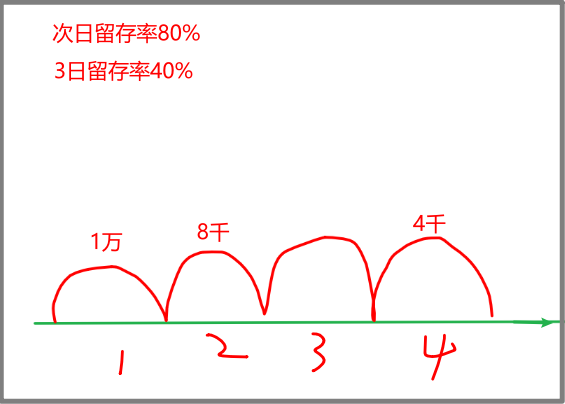
- 核心代码
-> where 日期 in (首日,1天后,7天后)
-> group by 用户
->count(if(日期=首日,1,null)) as cnt
count(if(日期=1天后,1,null)) as cnt2
count(if(日期=7天后,1,null)) as cnt8
->having cnt>0
->count(user_id) as 首日总数
count(if(cnt2>0,1,null)) as 次日留存数
count(if(cnt8>0,1,null)) as 7日留存数
->次日留存数/首日总数 as 次日留存率
7日留存数/首日总数 as 7日留存率- 先按用户分组,得到每个用户的各相关日期的登录情况。
select cuid,
count(if(event_day='2020-04-01',1,null)) as cnt,
count(if(event_day='2020-04-02',1,null)) as cnt2,
count(if(event_day='2020-04-08',1,null)) as cnt8
from tb_cuid_1d
--提前过滤数据
where event_day in ('2020-04-01','2020-04-02','2020-04-08')
group by cuid
-- 2020-04-01必须登录,剔除掉2020-04-01没登录的
having cnt>0- 效果如下

- 再对上面的用户汇总
select count(cnt) as uv,
count(if(cnt2!=0,1,null)) as uv2,
count(if(cnt8!=0,1,null)) as uv8
- 最后再用 【后续日期的留存数】除以【首日总数】,就是【留存率】
- 方案二
select count(a.cuid) uv,
count(b.cuid) uv2,
count(c.cuid) uv7
from (select distinct event_day, cuid from tb_cuid_1d where event_day='首日') as a
left join (select distinct event_day, cuid from tb_cuid_1d where event_day='次日') as b on a.cuid=b.cuid
left join (select distinct event_day, cuid from tb_cuid_1d where event_day='7日后') as c on a.cuid=c.cuid;腾讯视频号游戏直播
表:tableA
| ds(日期) | device | user_id | is_active |
|---|---|---|---|
| 2020-03-01 | ios | 0001 | 0 |
| 2020--0301 | ios | 0002 | 1 |
| 2020-03-01 | android | 0003 | 1 |
| 2020-03-02 | ios | 0001 | 0 |
| 2020-03-02 | ios | 0002 | 0 |
| 2020-03-02 | android | 0003 | 1 |
20200301的ios设备用户活跃的次日留存率是多少?
use test_sql;
set hive.exec.mode.local.auto=true;
--腾讯视频号游戏直播
drop table if exists tableA;
create table tableA
(ds string comment '(日期)' ,device string,user_id string,is_active int) ;
insert overwrite table tableA values
('2020-03-01','ios','0001',0),
('2020-03-01','ios','0002',1),
('2020-03-01','ios','0004',1),
('2020-03-01','android','0003',1),
('2020-03-02','ios','0001',0),
('2020-03-02','ios','0002',0),
('2020-03-02','android','0003',1),
('2020-03-02','ios','0005',1) ,
('2020-03-02','ios','0004',1) ;
--方案1,过程见下面的顺序编号
with t1 as (
select user_id,
--3-一个用户如果在'2020-03-01'活跃,则cnt1>0
count(if(ds = '2020-03-01', 1, null)) cnt1,
--4-一个用户如果在'2020-03-02'活跃,则cnt2>0
count(if(ds = '2020-03-02', 1, null)) cnt2
from tableA
--1-预先全局过滤
where device = 'ios'
and is_active = 1
and ds in ('2020-03-01', '2020-03-02')
--2-按用户分组
group by user_id
--6-只筛选'2020-03-01'活跃的用户,他在'2020-03-02'是否活跃,看cnt2=0则不活跃,>0则活跃
having cnt1 > 0
)
select count(cnt1) sum1,--'2020-03-01'的活跃数
count(if(cnt2 > 0, user_id, null)) sum2,----并且在次日依然活跃的用户数
count(if(cnt2 > 0, user_id, null)) / count(cnt1) rate--次日留存率
from t1;百度
有两张表
create table if not exists tb_cuid_1d
(
cuid string comment '用户的唯一标识',
os string comment '平台',
soft_version string comment '版本',
event_day string comment '日期',
timestamp int comment '用户访问时间戳',
duration decimal comment '用户访问时长',
ext array<string> comment '扩展字段'
);
insert overwrite table tb_cuid_1d values
(1,'android',1,'2020-04-01',1234567,100,`array`('')),
(1,'android',1,'2020-04-02',1234567,100,`array`('')),
(1,'android',1,'2020-04-08',1234567,100,`array`('')),
(2,'android',1,'2020-04-01',1234567,100,`array`('')),
(3,'android',1,'2020-04-02',1234567,100,`array`(''));
create table if not exists tb_account_1d
(
cuid string comment '用户的唯一标识',
uid string comment '登入用户账号名',
event_day string comment '日期'
);写出用户表 tb_cuid_1d的 20200401 的次日、次7日留存的具体HQL : 一条sql统计出以下指标 (4.1号uv,4.1号在4.2号的留存uv,4.1号在4.8号的留存uv);
--一个理解简单,但是性能不快的做法
select count(a.cuid) uv,
count(b.cuid) uv2,
count(c.cuid) uv7
from (select distinct event_day, cuid from tb_cuid_1d where event_day='2020-04-01') as a
left join (select distinct event_day, cuid from tb_cuid_1d where event_day='2020-04-02') as b on a.cuid=b.cuid
left join (select distinct event_day, cuid from tb_cuid_1d where event_day='2020-04-08') as c on a.cuid=c.cuid;
--另一个理解稍微复杂,但是性能快的做法
with t1 as (
select cuid,
count(if(event_day='2020-04-01',1,null)) as cnt1,
count(if(event_day='2020-04-02',1,null)) as cnt2,
count(if(event_day='2020-04-08',1,null)) as cnt8
from tb_cuid_1d
where event_day in ('2020-04-01','2020-04-02','2020-04-08')
group by cuid
having cnt1 >0
),
t2 as (select count(cuid) as uv1,
count(if(cnt2 > 0, 1, null)) as uv2,
count(if(cnt8 > 0, 1, null)) as uv7
from t1
)
select *,
uv2 / uv1 as `次日留存率`,
uv7 / uv1 as `7日留存率`
from t2分组内top前几
- 需求常见词:
- 【每组xxx内按yyy排序的前n个zzz】
- 【每组xxx内按yyy排序的第1个zzz】
- 【每组xxx内按yyy排序的最后1个zzz】
- 特点是yyy和zzz是不同的字段。
- 比如:班内按性别分组,组内按身高排序,的前3个学生姓名
- 公式:row_number() over(partition by 组名 order by yyy) as rn,再筛选rn<=N名
跨越物流
员工表结构 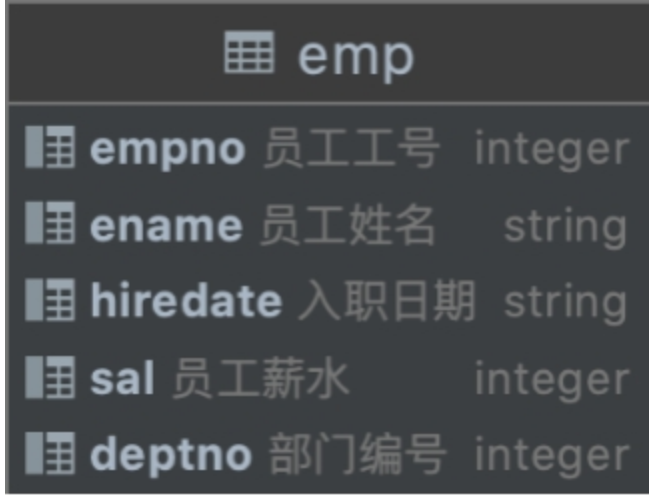 员工表数据
员工表数据 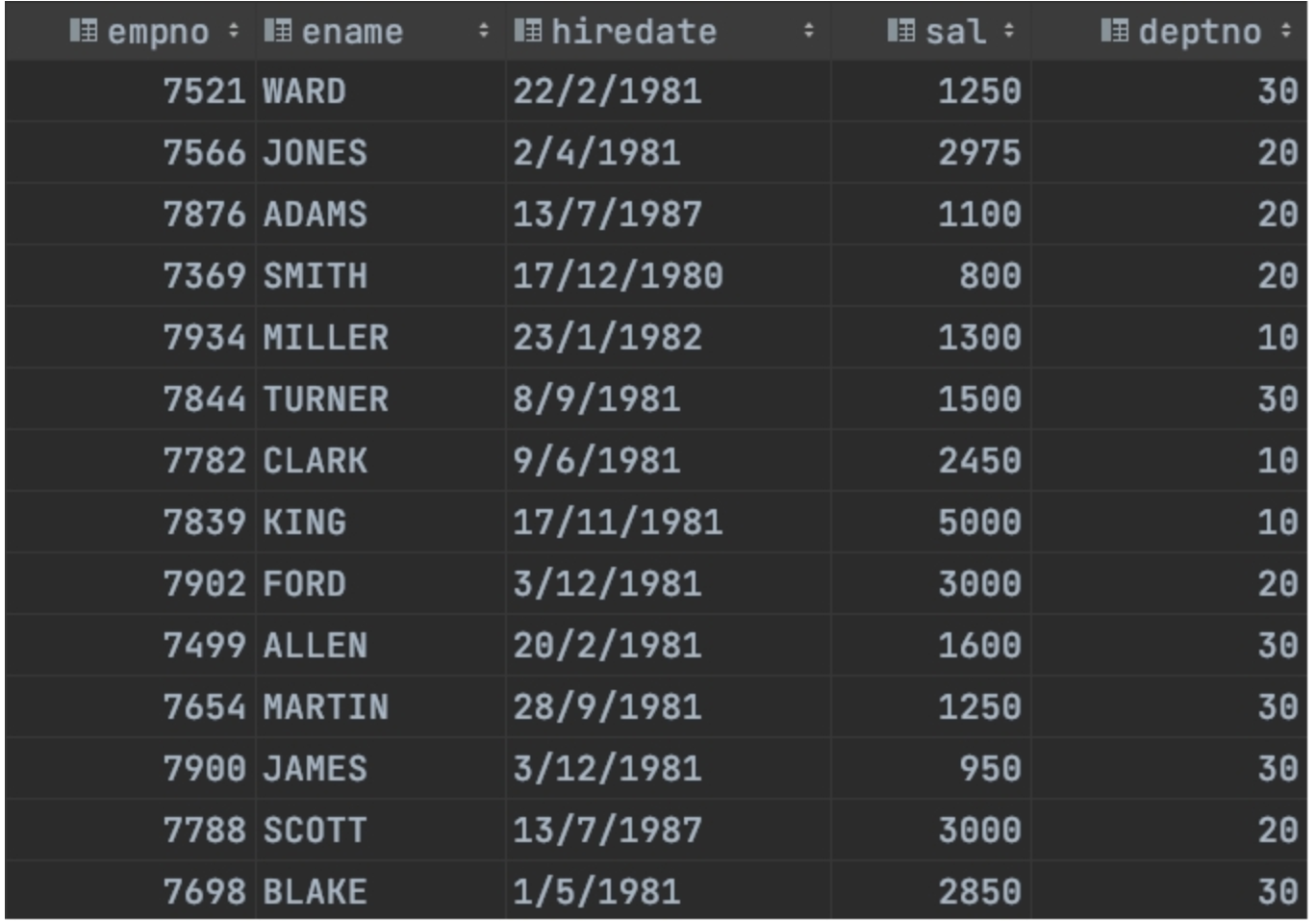 题目描述 求出每个部门工资最高的前三名员工,并计算这些员工的工资占所属部门总工资的百分比。 结果
题目描述 求出每个部门工资最高的前三名员工,并计算这些员工的工资占所属部门总工资的百分比。 结果 
create table emp(empno string ,ename string,hiredate string,sal int ,deptno string);
insert overwrite table emp values
('7521', 'WARD', '1981-2-22', 1250, 30),
('7566', 'JONES', '1981-4-2', 2975, 20),
('7876', 'ADAMS', '1987-7-13', 1100, 20),
('7369', 'SMITH', '1980-12-17', 800, 20),
('7934', 'MILLER', '1982-1-23', 1300, 10),
('7844', 'TURNER', '1981-9-8', 1500, 30),
('7782', 'CLARK', '1981-6-9', 2450, 10),
('7839', 'KING', '1981-11-17', 5000, 10),
('7902', 'FORD', '1981-12-3', 3000, 20),
('7499', 'ALLEN', '1981-2-20', 1600, 30),
('7654', 'MARTIN', '1981-9-28', 1250, 30),
('7900', 'JAMES', '1981-12-3', 950, 30),
('7788', 'SCOTT', '1987-7-13', 3000, 20),
('7698', 'BLAKE', '1981-5-1', 2850, 30);
select * from emp;
--求出每个部门工资最高的前三名员工,并计算这些员工的工资占所属部门总工资的百分比。
select a.empno,
a.sal,
a.deptno,
a.rn,
a.sum_sal,
round(a.sal/a.sum_sal,2) as rate
from
(select *,
--每个部门工资排名
row_number() over (partition by deptno order by sal desc) as rn,
--每个部门的总工资
sum(sal) over(partition by deptno ) as sum_sal
from emp) a
where rn<=3;小米电商
订单表,torder. 字段,user_id, order_id, ctime(10位时间戳),city id,sale_num,sku_id(商品) 问题:20201201至今每日订单量top10的城市及其订单量(订单量对order id去重)(在线写)
create table t_order (user_id string,
order_id string,
ctime string,
city_id string,
sale_num int ,
sku_id string) ;
with t1 as (select to_date(ctime) cdate, city_id, count(distinct order_id) cnt
from t_order
where to_date(ctime) >= '2020-12-01'
and to_date(ctime) <= `current_date`()
group by to_date(ctime), city_id),
t2 as (select *, row_number() over (partition by cdate order by cnt desc) rn from t1)
select cdate, city_id, cnt
from t2
where rn <= 10;窗口函数
- 窗口函数的最大特点是有over()关键字
- 聚合类的窗口函数
- sum() over()
- count/avg/max/min
- 排序类的窗口函数
- row_number,rank,dense_rank
- 偏移类的,跨行的
- lag / lead
- first_value/last_value
- ntile
交通银行
Emp表的表数据如下:
| NAME | MONTH | AMT |
|---|---|---|
| 张三 | 01 | 100 |
| 李四 | 02 | 120 |
| 王五 | 03 | 150 |
| 赵六 | 04 | 500 |
| 张三 | 05 | 400 |
| 李四 | 06 | 350 |
| 王五 | 07 | 180 |
| 赵六 | 08 | 400 |
问题:请写出可以得到以下的结果SQL
| NAME | 总金额 | 排名 | 占比 |
|---|---|---|---|
| 赵六 | 900 | 1 | 40.91% |
| 张三 | 500 | 2 | 22.73% |
| 李四 | 470 | 3 | 21.36% |
| 王五 | 330 | 4 | 15.00% |
create table emp(name string , month string, amt int);
insert overwrite table emp values ('张三', '01', 100),
('李四', '02', 120),
('王五', '03', 150),
('赵六', '04', 500),
('张三', '05', 400),
('李四', '06', 350),
('王五', '07', 180),
('赵六', '08', 400);
--rank 1224
--dense_rank 1223
with t1 as (select name,
sum(amt) as sum_amt
from emp
group by name),
t2 as (
select name,
sum_amt,
row_number() over (order by sum_amt desc) rn,
sum_amt/sum(sum_amt) over () as rate
from t1
)
select name, sum_amt, rn, concat(round(rate*100,2),'%') rate from t2跨越物流
题目描述 在第一题员工表的基础上,统计每年入职总数以及截至本年累计入职总人数。 截至本年累计入职总人数=本年总入职人数 + 本年之前所有年的总入职人数之和 结果 
select *,
sum(cnt) over (order by year1) cnt2
from
(select year(hiredate) as year1,
count(1) as cnt
from emp
group by year(hiredate)) a;join系列
【区分 inner /left / right / full / left semi / left anti join 的特点】 有以下银行信息表
use interview_db;
set hive.exec.mode.local.auto=true;
drop table if exists all_users;
create table all_users(
id int comment '用户id',
name string comment '用户姓名',
sex string comment '性别',
age int comment '年龄'
) comment '银行用户信息表';
insert overwrite table all_users values
(1,'张三','男',20),
(2,'李四','男',29),
(3,'王五','男',21),
(4,'赵六','女',28),
(5,'田七','女',22);
drop table if exists black_list;
create table black_list(
user_id int comment '用户编号',
type string comment '风控类型'
)comment '银行黑名单信息表';
insert overwrite table black_list values
(1,'诈骗'),
(2,'逾期'),
(3,'套现');left join
使用left join对所有用户,如果也在黑名单中,则标记为YES,否则标记为NO。
| id | name | sex | age | flag |
|---|---|---|---|---|
| 1 | 张三 | 男 | 20 | YES |
| 2 | 李四 | 男 | 29 | YES |
| 3 | 王五 | 男 | 21 | YES |
| 4 | 赵六 | 女 | 28 | NO |
| 5 | 田七 | 女 | 22 | NO |
select a.*,
if(b.user_id is not null, 'YES', 'NO') flag
from all_users a
left join black_list b
on a.id = b.user_id;right join
对上面的问题,使用right join再做一次。
| id | name | sex | age | flag |
|---|---|---|---|---|
| 1 | 张三 | 男 | 20 | YES |
| 2 | 李四 | 男 | 29 | YES |
| 3 | 王五 | 男 | 21 | YES |
| 4 | 赵六 | 女 | 28 | NO |
| 5 | 田七 | 女 | 22 | NO |
select b.*,
if(a.user_id is not null, 'YES', 'NO') flag
from black_list a
right join all_users b
on a.user_id = b.id;left semi join
使用left semi join对所有用户,如果也在黑名单中,则挑选出来。
| id | name | sex | age |
|---|---|---|---|
| 1 | 张三 | 男 | 20 |
| 2 | 李四 | 男 | 29 |
| 3 | 王五 | 男 | 21 |
select a.*
from all_users a
left semi join black_list b
on a.id = b.user_id;left anti join
使用left anti join对所有用户,如果不在黑名单中,则挑选出来。
| id | name | sex | age |
|---|---|---|---|
| 4 | 赵六 | 女 | 28 |
| 5 | 田七 | 女 | 22 |
select a.*
from all_users a
left anti join black_list b
on a.id = b.user_id;full join
--用户的存款金额。
drop table if exists deposit;
create table deposit (
user_id int comment '用户id',
amount int comment '存款金额'
)comment '用户最新银行存款信息表';
insert overwrite table deposit values
(1,2000),
(2,2900),
(3,2100);
--用户的负债金额。
drop table if exists debt;
create table debt (
user_id int comment '用户id',
amount int comment '负债金额'
)comment '用户最新银行负债信息表';
insert overwrite table debt values
(3,3400),
(4,2800),
(5,2200);使用full join,展示用户的存款金额和负债金额。
| user_id | deposit_amount | debt_amount |
|---|---|---|
| 1 | 2000 | 0 |
| 2 | 2900 | 0 |
| 3 | 2100 | 3400 |
| 4 | 0 | 2800 |
| 5 | 0 | 2200 |
select coalesce(a.user_id, b.user_id) as user_id,
coalesce(a.amount, 0) as deposit_amount,
coalesce(b.amount, 0) as debt_amount
from deposit a
full join debt b
on a.user_id = b.user_id;字节跳动
【考察full join】 1、某个游戏中的元宝分为,付费元宝和免费元宝。玩家购买商城道具时候,可以使用付费元宝也可以使用免费元宝。请使用HIve SQL语句计算出2021-01-01至2021-01-07期间各个角色当日消耗元宝的付费免费比例(付费免费比 = 付费元宝消耗量 / 免费元宝消耗量)。 现有表结构如下:
| desc | dm_paid_buy; |
|---|---|
| #dm_paid_buy | 角色使用付费元宝购买商城道具时候记录一条 |
| time | bigint | #购买的时间戳 |
|---|---|---|
| server_id | string | #服务器ID |
| role_id | int | #角色ID |
| cost | int | #购买对应道具消耗的付费元宝数量 |
| item_id | int | #购买对应道具的id |
| amount | int | #购买对应道具的数量 |
| p_date | string | #登录日期,yyyy-MM-dd |
| desc | dm_free_buy; |
|---|---|
| #dm_free_buy | 角色使用免费元宝购买商城道具时候记录一条 |
| time | bigint | #购买的时间戳 |
|---|---|---|
| server_id | string | #服务器ID |
| role_id | int | #角色ID |
| cost | int | #购买对应道具消耗的免费元宝数量 |
| item_id | int | #购买对应道具的id |
| amount | int | #购买对应道具的数量 |
| p_date | string | #登录日期,yyyy-MM-dd |
示例: 结果输出
| p_date | server_id | role_id | 付费免费比 |
|---|---|---|---|
| 2021-01-01 | 123 | 10098 | 0 |
| 2021-01-01 | 120 | 10098 | 0.4 |
| 2021-01-02 | 123 | 10098 | 0.2 |
use interview_db;
set hive.exec.mode.local.auto=true;
create table if not exists dm_paid_buy
(
`time` bigint comment '#购买的时间戳',
server_id string comment '#服务器ID',
role_id int comment '#角色ID',
cost int comment '#购买对应道具消耗的付费元宝数量',
item_id int comment '#购买对应道具的id',
amount int comment '#购买对应道具的数量',
p_date string comment '#登录日期, yyyy-MM-dd'
) comment '角色使用付费元宝购买商城道具时候记录一条';
insert overwrite table dm_paid_buy values
(1234567,120,10098,2,3,4,'2021-01-01'),
(1234567,120,10098,4,3,5,'2021-01-01'),
(1234567,123,10098,3,3,2,'2021-01-02'),
(1234567,123,10098,2,3,2,'2021-01-02');
-- 查看表结构
desc dm_paid_buy;
create table if not exists dm_free_buy
(
`time` bigint comment '#购买的时间戳',
server_id string comment '#服务器ID',
role_id int comment '#角色ID',
cost int comment '#购买对应道具消耗的免费元宝数量',
item_id int comment '#购买对应道具的id',
amount int comment '#购买对应道具的数量',
p_date string comment '#登录日期, yyyy-MM-dd'
) comment '角色使用免费元宝购买商城道具时候记录一条';
insert overwrite table dm_free_buy values
(1234567,123,10098,8,3,4,'2021-01-01'),
(1234567,123,10098,5,3,5,'2021-01-01'),
(1234567,120,10098,6,3,4,'2021-01-01'),
(1234567,120,10098,9,3,5,'2021-01-01'),
(1234567,123,10098,18,3,2,'2021-01-02'),
(1234567,123,10098,7,3,2,'2021-01-02');
select coalesce(a.p_date, b.p_date) p_date,
coalesce(a.server_id, b.server_id) server_id,
coalesce(a.role_id, b.role_id) role_id,
round(nvl(a.cost, 0) / b.cost, 3) as rate
from (select p_date, server_id, role_id, sum(cost) cost
from dm_paid_buy
where p_date >= '2021-01-01'
and p_date <= '2021-01-07'
group by p_date, server_id, role_id) a
full join (select p_date, server_id, role_id, sum(cost) cost
from dm_free_buy
where p_date >= '2021-01-01'
and p_date <= '2021-01-07'
group by p_date, server_id, role_id) b
on a.p_date=b.p_date and a.server_id=b.server_id and a.role_id=b.role_id;join优化
通用口诀:先用where或group by减少数据量,再join
--优化前,慢:
select b.userid.
b.username,
sum(xx),
count(xx)
from a【比如交易明细事实表】
join b【比如客户维度信息表】
on a.userid=b.userid
where b.yy<条件
group by b.userid.b.username
having count(a.xx) >10;
--优化后,快:
select b.userid.
b.username,
s,
cnt
--【提前对a减少数据量】
from (select userid,
sum(xx) s,
count(xx) cnt
from a group by userid having count(a.xx) >10)a
--【提前对b减少数据量】
join (select * from b where b.yy<条件) b
on a.userid=b.userid
;交通银行
数据模型如下: 表T1的数据结构:
| 字段英文名 | 字段中文名 | 类型 | 主键标志 | 注释 |
|---|---|---|---|---|
| Rec_no | 记录号 | CHAR(3) | Y | |
| Ci_no | 客户号 | CHAR(6) | N | |
| Cust_Type | 客户类型 | CHAR(2) | N | |
| Cre_dt | 开户日期 | Date | N | |
| Cus_sts | 客户状态 | Char(1) | N | Y-正常 N-无效 |
表T1的数据
| Rec_no | ci_no | cust_type | cre_dt | cus_sts |
|---|---|---|---|---|
| 123 | 111111 | 01 | 2010-11-15 | Y |
| 234 | 222222 | 02 | 2011-09-01 | Y |
| 345 | 333333 | 02 | 2012-01-09 | Y |
| 456 | 444444 | 01 | 2012-09-08 | Y |
表T2的数据结构:
| 字段英文名 | 字段中文名 | 类型 | 主键标志 | 注释 |
|---|---|---|---|---|
| Ci_no | 客户号 | CHAR(6) | Y | |
| AC_no | 客户账号 | CHAR(9) | Y | |
| Bal | 账号余额 | DECIMAL(15,2) | N |
表T2的数据:
| Ci_no char(6) | Ac_no char(9) | Bal decimal(15,2) |
|---|---|---|
| 222222 | 123456888 | 1000.28 |
| 222222 | 123456999 | 886 |
| 333333 | 123454321 | 5000 |
请编写sql统计在9月份开户且账户余额不为0的有效客户数。(8分)
create table T1
(
rec_no int,
ci_no int,
cust_type string,
cre_dt string,
cus_sts string
);
insert overwrite table T1 values
(123,111111,'01','2010-11-15','Y'),
(234,222222,'02','2011-09-01','Y'),
(345,333333,'02','2012-01-09','Y'),
(456,444444,'01','2012-09-08','N');
select * from T1;
create table T2
(
ci_no int,
ac_no string,
bal decimal(7,2)
);
insert overwrite table T2 values
(222222,'123456789',1000.28),
(222222,'123456999',886),
(333333,'123454321',5000.00);
select * from T2;
-- 传统的写法。
select count(distinct t1.ci_no) as cnt
from t1
join t2 on t1.ci_no=t2.ci_no
where month(t1.cre_dt)=9
and t1.cus_sts='Y'
and bal>0;
-- 方案2
select count(t1.ci_no) as cnt
from (select * from t1 where month(cre_dt)=9 and cus_sts='Y') t1
join (select ci_no from t2 group by ci_no having sum(bal)>0) t2
on t1.ci_no=t2.ci_no;带条件的聚合统计
- 一般的做法是group by xx,yy 再多次的sum(if(......))
- 好处是避免多次加载表,一次性得到多个指标,可以只加载一次表就得到多个指标。
小米电商
要求:编写SQL能运行,数据正确且符合规范,如遇到自定义函数或不记得的函数可以用XX代替 1.已知有如下两个表sale:字段如下
Create table sale_order(
Order_id bigint comment '订单ID',
User_id bigint comment '用户ID',
Order_status int,
Create_time string,
Last_update_time string,
Product_id bigint,
Product_num bigint
);用户注册表:
Create table user_info(
user_id bigint comment'用户ID,唯一主键',
sex string.
age int
);问题:用一条SQL生成完整的用户画像表,包含如下字段: user_id, sex, age, d7order_num, d14_order_num,后面两个字段分别为近7天订单数量,近14天订单数量。
create table sale_order(
order_id bigint comment '订单ID',
user_id bigint comment '用户ID',
order_status int ,
create_time string,
last_update_time string,
product_id bigint,
product_num bigint
);
create table user_info(
user_id bigint comment '用户ID,唯一主键',
sex string,
age int
);
select u.user_id,
s.d7order_num,
s.d14order_num
from user_info u
left join (select user_id,
count(if(create_time >= '7天前' and create_time <= '今天', order_id,null)) as d7order_num,
count(if(create_time >= '14天前' and create_time <= '今天', order_id,null)) as d14order_num
from sale_order
where create_time >= '14天前'
group by user_id) s on u.user_id = s.user_id;华泰证券2
- 查询课程编号“2”的成绩比课程编号“1”低的所有同学的学号、姓名。
- 【这是行转列的衍生题】
create table student(sid int, sname string, gender string, class_id int);
insert overwrite table student
values (1, '张三', '女', 1),
(2, '李四', '女', 1),
(3, '王五', '男', 2);
select * from student;
create table course (cid int, cname string, teacher_id int);
insert overwrite table course
values (1, '生物', 1),
(2, '体育', 1),
(3, '物理', 2);
select * from course;
create table score (sid int, student_id int, course_id int, number int);
insert overwrite table score
values (1, 1, 1, 58),
(4, 1, 2, 50),
(2, 1, 2, 68),
(3, 2, 2, 89);
select * from score;
with t1 as(
select student_id,
sum(if(course_id=2,number,0)) as pe, --体育
sum(if(course_id=1,number,0)) as bio --生物
from score
group by student_id
having pe<bio)
select sid, sname
from t1
join student
on t1.student_id = sid
;explode爆炸函数
公式:用【lateral view】+【explode】将大字段拆解成小字段:
select 主表名.旧字段,视图名.新字段 from 主表名 lateral view explode(数组字段) 视图名 as 新字段名腾讯QQ
假设tableA , tableB , tableB
| qq号(字段名:qq) | 游戏(字段名:games) |
|---|---|
| 10000 | a_b_c |
| 20000 | c_d |
tableA
| qq号(字段名:qq) | 游戏(字段名:game) |
|---|---|
| 10000 | a |
| 10000 | b |
| 10000 | c |
| 20000 | c |
| 20000 | d |
将tableB输出为tableA的格式;
use interview_db;
set hive.exec.mode.local.auto=true;
create table tableA(qq string, game string)
insert overwrite table tableA values
(10000, 'a'),
(10000, 'b'),
(10000, 'c'),
(20000, 'c'),
(20000, 'd');
create table tableB(qq string, game string) ;
insert overwrite table tableB values
(10000, 'a_b_c'),
(20000, 'c_d');
select qq,
tmp.game
from tableB lateral view explode(split(game, '_')) tmp as game;vivo
用户常驻城市信息表addr_info: uid, addr_list 数据示例: "001",【"深圳,东莞,广州"】 "002",【"深圳,佛山,广州"】 用户基本信息表user:uid,name,gender,birth ,addr_list 问题:常驻人数top10的城市,男女比例的人数分布情况,要求结果如下: 城市名称,排名,男性人数,女性人数 "北京", 1, 20008, 25005 "深圳", 2, 23408, 30005
use interview_db;
set hive.exec.mode.local.auto=true;
drop table if exists user_info;
create table user_info(
uid string,
name string,
gender string,
birth string,
----数组array,map,struct都是复杂类型
addr_list array<string>
);
insert overwrite table user_info values
('001','zs','male','1995-01-01',array('深圳','东莞','广州')),
('002','ls','female','1996-01-01',array('深圳','佛山','广州'));
with t1 as (
select uid,gender,addr from user_info lateral view explode(addr_list) view1 as addr
) ,
t2 as (
select t1.addr,
--统计每个城市的人数,方便后续排序
count(t1.uid) cnt,
count(if(gender='male',t1.uid,null)) cnt_male, --男性人数
count(if(gender='female',t1.uid,null)) cnt_female--男性人数
from t1
group by t1.addr
)
select addr,
row_number() over (order by cnt desc) rn,
cnt_male,
cnt_female
from t2 ;CTE语句(with as语句)
擅长解决,步骤很多,逻辑非常复杂的需求。 语法:
with 临时表名1 as (
select 语句1
), 临时表名2 as (
select 语句2【可以直接用前面的临时表名】
),
。。。。。。
select * from 临时表名n字节跳动
一款MMORPG游戏有一个每日任务设计,完成不同任务可以获得不同的活跃度奖励。当日活跃度累计超过100,就可以获得一个活跃宝箱(获得宝箱后玩家仍然会继续参加任务获得活跃度,但不会有额外奖励)。活跃度会每日清零,活跃任务也是每日刷新。现有表结构如下 表dm_activity_di(当角色每完成一个任务时候,记录一条获取活跃度的日志):
| role_id | int | #角色id |
| task_id | int | #本次完成的任务id |
| activity_add | int | #本次角色获取的活跃度 |
| p_date | string | #日志触发的日期, yyyy-MM-dd |
| time | bigint | #该日志的触发时间戳 |
drop table dm_activity_di;
create table if not exists dm_activity_di
(
role_id string comment '#角色id',
task_id int comment '#本次完成的任务id',
activity_add int comment '#本次角色获取的活跃度',
p_date string comment '#日志触发的日期, yyyy-MM-dd',
time string comment '#该日志的触发时间戳'
) comment '当角色每完成一个任务时候,记录一条获取活跃度的日志';
insert overwrite table dm_activity_di
values ('小红', 12, 20, '2021-01-01', '2021-01-01 10:00:00'),
('小红', 13, 30, '2021-01-01', '2021-01-01 11:00:00'),
('小红', 1, 10, '2021-01-01', '2021-01-01 12:00:00'),
('小红', 3, 60, '2021-01-01', '2021-01-01 13:00:00'),
('小红', 6, 30, '2021-01-01', '2021-01-01 14:00:00'),
('小李', 17, 20, '2021-01-01', '2021-01-01 08:00:00'),
('小李', 14, 30, '2021-01-01', '2021-01-01 09:00:00'),
('小李', 3, 40, '2021-01-01', '2021-01-01 10:00:00'),
('小李', 5, 20, '2021-01-01', '2021-01-01 11:00:00'),
('小李', 1, 30, '2021-01-01', '2021-01-01 12:00:00'),
('小明', 8, 20, '2021-01-01', '2021-01-01 13:00:00'),
('小明', 4, 10, '2021-01-01', '2021-01-01 14:00:00'),
('小明', 5, 10, '2021-01-01', '2021-01-01 15:00:00'),
('小明', 31,50, '2021-01-01', '2021-01-01 16:00:00'),
('小明', 9, 30, '2021-01-01', '2021-01-01 17:00:00'),
('小明', 9, 20, '2021-01-01', '2021-01-01 18:00:00');1)统计一下2021-01-01当天,各个服务器的各个角色在完成各个任务时累积已获得的活跃度。 示例: 一个角色在一天内全部的活跃度获取日志
| role_id | task_id | activity_add | p_date | time |
|---|---|---|---|---|
| 小红 | 12 | 20 | 2021-01-01 | 2021-01-01 10:00:00 |
| 小红 | 13 | 30 | 2021-01-01 | 2021-01-01 11:00:00 |
| 小红 | 1 | 10 | 2021-01-01 | 2021-01-01 12:00:00 |
| 小红 | 3 | 60 | 2021-01-01 | 2021-01-01 13:00:00 |
| 小红 | 6 | 30 | 2021-01-01 | 2021-01-01 14:00:00 |
结果输出
| role_id | task_id | activity_add | p_date | time | 累积获得的活跃度 |
|---|---|---|---|---|---|
| 小红 | 12 | 20 | 2021-01-01 | 2021-01-01 10:00:00 | 20 |
| 小红 | 13 | 30 | 2021-01-01 | 2021-01-01 11:00:00 | 50 |
| 小红 | 1 | 10 | 2021-01-01 | 2021-01-01 12:00:00 | 60 |
| 小红 | 3 | 60 | 2021-01-01 | 2021-01-01 13:00:00 | 120 |
| 小红 | 6 | 30 | 2021-01-01 | 2021-01-01 14:00:00 | 150 |
select *,
sum(activity_add) over (partition by p_date, role_id order by `time` ) sum1
from dm_activity_di2)统计一下2021-01-01当天,角色获得活跃度宝箱时候所完成的任务数量分布。 示例:结果输出
| p_date | 获得宝箱时候的任务数量 | 角色数 |
|---|---|---|
| 2021-01-01 | 4 | 2 |
| 2021-01-01 | 5 | 1 |
【活跃度累计超过100】等价于【获得1个宝箱】 


--步骤清晰法
with t1 as (select *,
sum(activity_add) over (partition by p_date, role_id order by `time` ) sum1
from dm_activity_di),
t2 as (select *,
row_number() over (partition by p_date,role_id order by `time`) cnt
from t1),
t3 as (select *from t2 where sum1 > 100),
t4 as (select *,
row_number() over (partition by p_date,role_id order by sum1 ) as rn1
from t3),
t5 as (select *from t4 where rn1 = 1)
select p_date,
cnt,
count(role_id) as num_roles
from t5
group by p_date, cnt;
----简化写法
select *,
sum(activity_add) over (partition by p_date, role_id order by `time` ) `累积获得的活跃度`
from dm_activity_di where role_id='小红';
with t1 as (
select *,
sum(activity_add) over (partition by p_date, role_id order by `time` ) sum1,
--得到当前活跃度时,闯了几关,
row_number() over (partition by p_date,role_id order by `time`) cnt
from dm_activity_di
) ,
t2 as (
select *,
row_number() over (partition by p_date,role_id order by sum1 ) as rn1
from t1 where sum1>100
)
select p_date,cnt,
count(role_id) as num_roles
from t2 where rn1=1
group by p_date,cnt;综合案例
腾讯互娱
- 窗口函数+行转列+CTE语法
题目:有一个流水表,用户1在什么时间玩了什么游戏,
create or replace temporary view user_login(dtstatdate, qq, dteventtime, game)
as
values ("20220110", 1, '2022/1/10 0:04', "王者荣耀"),
("20220110", 1, '2022/1/10 0:04', "王者荣耀"),
("20220110", 1, '2022/1/10 10:14', "王者荣耀"),
("20220110", 1, '2022/1/10 11:02', "天刀"),
("20220110", 1, '2022/1/10 11:02', "天刀"),
("20220110", 1, '2022/1/10 12:14', "王者荣耀"),
("20220110", 2, '2022/1/10 10:13', "数码宝贝"),
("20220110", 2, '2022/1/10 15:58', "lol"),
("20220110", 2, '2022/1/10 17:11', "lol");
SELECT * FROM user_login;需求:处理一下某个用户的玩游戏的先后顺序链条,按照时间排序后游戏相同的要合并 例子:AABBA需要合并成ABA 例子结果:
| dtstatdate | time_set | game_set | |
|---|---|---|---|
| 20220110 | 1 | 2022/1/10 0:04,2022/1/10 11:02,2022/1/10 12:14 | 王者荣耀,天刀,王者荣耀 |
| 20220110 | 2 | 2022/1/10 10:13,2022/1/10 15:58 | 数码宝贝,lol |
代码:
with t1 as (
select *,
--1-标记每天每用户,每次游戏的上次游戏是什么。目的是为了借助错位1行,对相同游戏去重复,间接合并相邻的2次游戏。
lag(game, 1, '') over (partition by dtstatdate,qq order by dteventtime) last
from user_login
),
t2 as (
select dtstatdate, qq, dteventtime, game
from t1
--2-借助错位1行,对相同游戏去重复,间接合并相邻的2次游戏。
where game != last
),
t3 as (
--3-将时间和游戏,绑在一起合成整体。
select *, concat(dteventtime, '-', game) time_game
from t2
),
t4 as (
--4-将上一步每个整体,装进一个数组容器中。
select dtstatdate, qq,
collect_list(time_game) time_games
from t3 group by dtstatdate, qq
),
t5 as (
select dtstatdate,
qq,
--5-对上一步的数组容器中的每个整体进行排序,
--具体是按照每个整体的前半部分也就是日期排序。
--array_sort函数,用法是对数组容器的每个元素两两之间比较排序,left, right就是每次两两之间比较的意思。
--负1表示左比右小,正1表示左比右大,零表示二者相等。
array_sort(time_games,
(left, right) ->(
case
when split(left,'-')[0] < split(right,'-')[0] then -1
when split(left,'-')[0] > split(right,'-')[0] then 1
else 0 end)
) sorted_games
from t4
),
t6 as (
select *,
--6-上一步排好序的大数组容器中,每个元素是【时间-游戏名】整体,将大数组容器还原拆成2个小数组容器,
-- 第1个数组中都是时间,第2个数组中都是游戏名。
-- transform函数用法是对数组每个元素进行转换。x名字随便取,表示每个元素。
transform(sorted_games, x->split(x, '-')[0]) time_array,
transform(sorted_games, x->split(x, '-')[1]) games_array
from t5
),
t7 as (
--7-将每个小数组容器的元素用字符串表示
select dtstatdate, qq,
concat_ws(',', time_array) time_set,
concat_ws(',', games_array) game_set from t6
)
select * from t7 ;巴别时代
- 考验行转列
role_login
| 字段名 | 类型 | 含义 |
|---|---|---|
| server_id | int | '服务器id', |
| pid | int | '用户平台id', |
| plosgn | int | '用户所属平台的id', |
| log_time | int | '登入时间戳', |
| ds | string | '日期', |
| gn | string | '游戏名' |
role_login
| server_id | pid | plosgn | log_time | ds | gn |
|---|---|---|---|---|---|
| 3000001 | 510166 | 1 | 1626565553 | 2021-07-18 | A |
| 3000001 | 510166 | 1 | 1626568224 | 2021-07-18 | A |
| 3000001 | 510166 | 1 | 1626574517 | 2021-07-18 | B |
| 3000001 | 510047 | 8 | 1626585497 | 2021-07-18 | C |
| 3000001 | 510047 | 8 | 1626659972 | 2021-07-19 | D |
| 3000008 | 510013 | 1 | 1626660317 | 2021-07-19 | D |
| 3000008 | 510013 | 1 | 1626662251 | 2021-07-19 | T |
| 3000001 | 782902 | 16 | 1626662577 | 2021-07-19 | Y |
| 3000001 | 782902 | 16 | 1626662895 | 2021-07-19 | Y |
| 3000001 | 782902 | 16 | 1626663542 | 2021-07-19 | Y |
| 3000001 | 510062 | 7 | 1626663914 | 2021-07-19 | Y |
| 3000001 | 510062 | 7 | 1626664080 | 2021-07-19 | Y |
列出在2021年5月有过登录,2021年6月没有登录,2021年7月又登录过游戏D的用户信息(需展示的字段为server_id,pid)
select server_id, pid
from (select *,
count(if(substr(ds, 0, 7) = '2021-05', 1, null)) over (partition by pid ) cnt1,
count(if(substr(ds, 0, 7) = '2021-06', 1, null)) over (partition by pid ) cnt2,
count(if(substr(ds, 0, 7) = '2021-07', 1, null)) over (partition by pid ) cnt3
from role_login
where gn = 'D'
and substr(ds, 0, 7) in ('2021-05', '2021-06', '2021-07')
) t
where cnt1 > 0
and cnt2 = 0
and cnt3 > 0;
